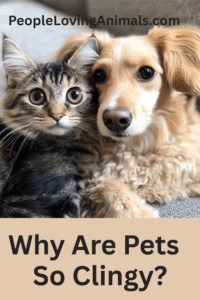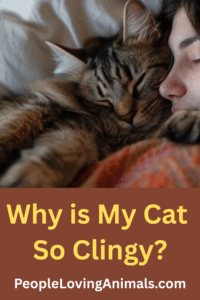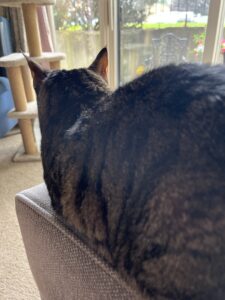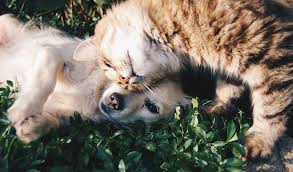Do you have a dog or cat who won’t leave your side? Maybe they follow you from room to room, whine when you leave, or even become distressed if you’re not within view. While the affection might feel flattering at first, overly clingy behavior—also known as having a “Velcro pet”—can become stressful for both you and your pet.
In this post, we’ll explore the most common reasons dogs and cats become overly clingy, how to tell if it’s a behavior issue or anxiety, and what you can do to help your pet feel more independent and secure.
But first…if your pet is being clingy all of a sudden and you feel like it’s severe or just way out of character for them, please give the vet a call. We’ll talk later in this post about what to look for to determine if your pet may be having a serious issue.
Watch My Video: Why is My Pet So Clingy?
This post contains affiliate links. If you make a purchase, I’ll earn a commission (at no extra cost to you). As an Amazon Associate, I earn from qualifying purchases. I donate 10% of my profits to animal charities.
What Is a Velcro Pet?
The term “Velcro pet” refers to an animal that’s excessively attached to its owner. These pets stick to you like glue—following you from room to room, needing constant attention, or panicking when you leave the house.
While some breeds (like Labrador Retrievers or Siamese cats) are more prone to clinginess due to their loyal or social nature, clingy behavior can also be a sign of anxiety or lack of confidence—especially if it escalates over time.
👉 Download our free guide: “7 Ways to Help a Clingy Pet Feel More Secure”
Why Is My Dog So Clingy All of a Sudden?
A sudden change in your dog’s behavior is often a red flag that something is wrong. Common causes of sudden clinginess in dogs include:
-
-
- Separation anxiety
- Recent life changes (like a move or new baby)
- Illness or pain
- Trauma or a past abandonment
-
If your dog was previously independent but is now glued to your side, they may be experiencing emotional distress.
To learn whether your dog may have separation anxiety, read my post, Treating Dog Separation Anxiety (includes video).
Also consider whether your dog is experiencing anxiety. For more information, read my post, What is Dog Anxiety? (includes video).
Why Is My Cat Suddenly Clingy?
Cats are known for being independent, but some cats become extremely needy. If your cat is meowing constantly, always wants to be held, or won’t let you leave the room without following, it could be due to:
-
-
- Stress from environmental changes
- Boredom or loneliness
- Health issues
- Past neglect or trauma
-
Just like dogs, cats can suffer from anxiety. Get help from my post, What is Cat Anxiety? (includes video).
Also check out my post, Separation Anxiety in Cats (includes video).
You may also get some more tips from my post, Why Does My Cat Keep Meowing? (includes video).
Is It Clinginess or Separation Anxiety?
Clingy behavior is different from full-blown separation anxiety, but they often overlap. Here’s how to tell the difference:
| Clingy Pet | Separation Anxiety |
|---|---|
| Follows you around | Panics when left alone |
| Wants attention often | Destructive when alone |
| Sleeps near you | Paces, howls, or drools when you leave |
| Watches for your return | Attempts to escape confinement |
If your pet exhibits destructive or panic-like behaviors when you’re gone, they may have separation anxiety. Learn more in my post, Signs Your Pet May Have Separation Anxiety.
Are Certain Breeds More Clingy Than Others?
Yes. Some breeds are genetically predisposed to be more attached to their humans. For dogs, these include:
-
-
- Labrador Retrievers
- Border Collies
- Vizslas
- German Shepherds
- Chihuahuas
-
Clingy cat breeds include:
-
-
- Siamese
- Ragdolls
- Sphynx
- Burmese
- Scottish Folds
-
If you have one of these breeds, they may naturally seek more closeness—but that doesn’t mean anxiety should be ignored.
My Cat Whiskers is Sometimes Clingy
My cat, Whiskers, isn’t necessarily clingy. At least I wouldn’t classify him as such! Of course he loves Mommy, snuggles with me all the time, sleeps next to me in bed at night…but I don’t consider him clingy.
But…if there’s a loud noise outside like a lawn mower or even a moving truck or an Amazon or UPS truck using their back-up beep, he sits right on top of me! That’s him in the pic sitting on the arm of the couch right next to me because there was a guy using a weed eater outside! LOL
Should I Encourage or Correct Clingy Behavior?
While it’s okay to give your pet love and affection, reinforcing their clingy behavior can make things worse. Try the following:
- Avoid rewarding attention-seeking behavior. If your dog constantly nudges you or your cat meows non-stop, wait until they’re calm before giving attention.
- Promote independence. Give them puzzles, toys, or enrichment activities that don’t involve you.
- Create a safe space. Give your pet a cozy bed or corner where they feel comfortable being alone for short periods.
What Are Some Natural Ways to Reduce Your Pet’s Clinginess?
Natural methods to reduce your pet’s anxiety and build confidence include:
-
-
- Calming music or pheromone diffusers
- Interactive toys (like KONGs or cat tunnels)
- Routine and predictability
- Daily mental stimulation and training
- Sufficient daily exercise
-
Many clingy pets are simply under-stimulated and anxious. Structure and confidence-building activities can do wonders.
How Can I Train My Pet to Be More Independent?
Training is essential. For dogs, I highly recommend The Dog Calming Code by Doggy Dan. It’s a gentle, natural method that helps dogs feel secure while teaching them to trust you as their pack leader.
Also check out my post, How to Boost Your Dog’s Confidence (includes video).
For cats, independence-building means:
-
- Letting them initiate affection
- Ignoring (or at least not rewarding) constant meowing
- Teaching them to play alone
It may seem tough at first, but gentle consistency works. To learn more about how to communicate with your cat and understand what your cat is trying to say, check out this eBook, The Cat Language Bible.
Should I Be Worried About My Pet’s Clingy Behavior?
Clinginess is only a problem if it causes stress for you or distress for your pet. Warning signs include:
-
-
- Destructive behavior
- Loss of appetite
- Physical symptoms (vomiting, diarrhea, constant pacing)
- Self-harm (excessive licking or chewing)
-
If these behaviors are present, your pet may be suffering from serious anxiety or a medical issue and needs help—starting with training, and possibly veterinary input.
Like I said at the beginning of this post, if it’s weird…and your gut will tell you that…it’s wise to give the vet a call.
When to Get Help from a Professional
If your efforts to increase your pet’s independence aren’t working—or if the clinginess seems to be getting worse—it may be time to consult:
- A certified dog trainer (preferably one using calm, non-violent techniques like Doggy Dan)
- A feline behaviorist (Check out Jackson Galaxy on YouTube)
- Your veterinarian, to rule out health problems
Final Thoughts on Velcro Pets
Having a pet who adores you is a wonderful thing—but when that love turns into constant neediness, it’s time to help them feel more confident and calm on their own.
You and your pet both deserve a peaceful, balanced life together. Let’s help them feel safe—even when you’re not right there.
You might enjoy this article called, 17 Clingy Pets Who Made People Forget About Personal Space. Cute!
More Help with Pet Care
- Where to Find a Pet - Search Near Your Area
- How to Choose the Right Pet
- Bringing Home a New Pet
- How Often to Bathe Your Pets
- Keeping Pets Entertained While at Work
- Signs Your Pet May Have Separation Anxiety
- Pet Day Care - What You Need to Know
- 6 Myths About Cats and Dogs
- Best Value on Pet Supplies – Save Up to 50% at Pets Warehouse
- Pet Training - My Top Recommendations
- How to Remove Pet Urine Stains from Carpet
- Pet Supplies on eBay – Save a Ton
- Simple Steps to Get Rid of Pet Dander
- Understanding Your Pet’s Body Language and Emotions
- Creative Ways to Celebrate Your Pet’s Birthday
- Fun Activities to Do with Your Pets
- Why Is My Pet So Clingy?
I Donate to Animal Charities
Thanks for visiting my site! I hope this post gave you effective tips to help with your pet’s clingy behavior.
You should know I receive a small commission on some of the services and products I recommend on my site. I donate 10% of my profits to the animal charities shown here.
If you enjoyed this post, please share my site with other pet lovers!















This was super helpful—thank you! I always thought my dog was just extra affectionate, but now I see there might be more going on. The tips about building independence and not rewarding clingy behavior really make sense. I’m going to try some of the calming tools and puzzle toys you suggested!
Ask ChatGPT
Great! Feel free to come back and tell me how you make out… Debra